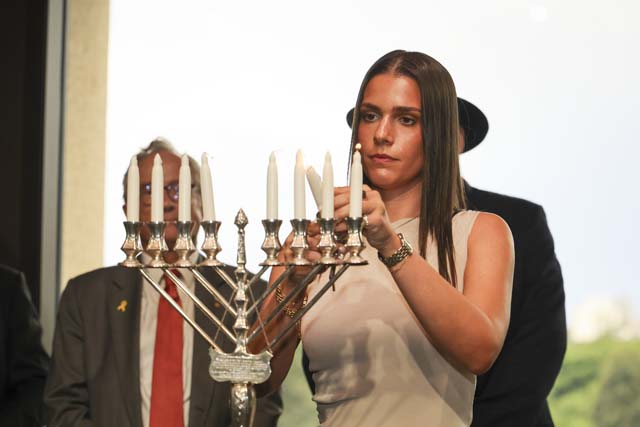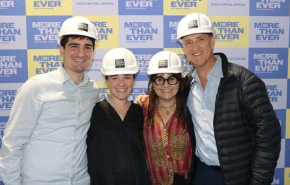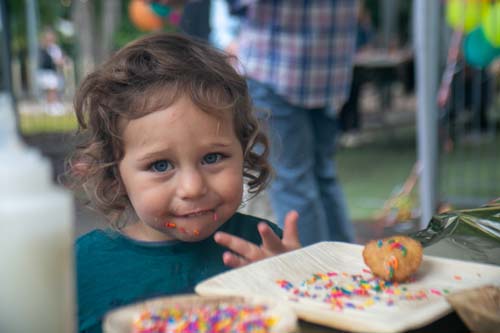Ittay Flescher’s dream of enduring peace
Book review by Dr Anne Sarzin
 Dreams are enshrined in the biblical literature of Jewish people; our patriarch Jacob dreamed of a ladder with angels ascending and descending, generating over thousands of years a multiplicity of interpretations. Jacob’s angels were emissaries of God, bringing divine light from above and also demonstrating it is possible for our better angels to ascend to great heights.
Dreams are enshrined in the biblical literature of Jewish people; our patriarch Jacob dreamed of a ladder with angels ascending and descending, generating over thousands of years a multiplicity of interpretations. Jacob’s angels were emissaries of God, bringing divine light from above and also demonstrating it is possible for our better angels to ascend to great heights.
Ittay Flescher, the Israeli-Australian author of The Holy and the Broken, also dreams of a pathway traversing the Holy Land, a potential road for peace leading Palestinians and Israelis through a landscape shared in harmony and safety. Who wouldn’t applaud such a dream if it were to be fulfilled in an ideal world?
Flescher notes, ‘There are many reasons why I need to believe that peace is possible. If it is a choice between holding on to this distant dream or accepting that our fate is an endless war, as most in Israel do. I believe the Jewish story propels us to choose and believe in the good option, the option that affirms life and the best in humanity. If we choose the other option, peace will elude us.’
The struggle between Israelis and Palestinians, he writes, seems never-ending; but he takes heart from the successful resolution of seemingly entrenched and intractable conflicts elsewhere in the world: the Camp David Accords in 1978 ensured a lasting peace between Israel and Egypt; the Dayton Peace Agreement in 1995 ended the Bosnian/Herzegovina war; the 1992 Chapultepec Peace Accords ended the Salvadoran civil war; negotiations ended apartheid in South Africa; peace and reconciliation followed the Rwandan genocide; and the emergence of the European Union ensured the abolition of border controls and checkpoints across 29 countries. According to Flescher, ‘even the most horrific conflicts can end when those affected decide that they can resolve their differences and achieve their political aims through better means’.
Born in Israel but growing up in Australia, Flescher’s family background and mentors, educational qualifications and professional experience as a high-school educator all equipped him to envision and work towards a roadmap for peace in Israel and the Palestinian territories. From his days as a teacher in several schools across Melbourne, he has been preoccupied with the resolution of conflicts and viable prospects for peace. With his return to Israel in 2018, he was appointed education director of Kids4Peace in Jerusalem, an international NGO founded in 2002, which merged in 2020 with Seeds of Peace. Kids4Peace brings together Israeli and Palestinian teenagers—Muslim, Jewish and Christian—in a bi-weekly dialogue program conducted in Hebrew and Arabic. The organisation reflects Flescher’s own mission of peacebuilding, the promotion of tolerance, understanding and the creation of non-violent solutions, bringing justice and equality for all. He believes that graduates of this program enter adulthood prepared for the toughest issues, ‘building trust, exchanging ideas respectfully and confronting a generational conflict together’.
And then Hamas invaded Israel on 7 October 2023. In the morass of warfare and polarised debate that followed, Flescher spoke with friends in media and politics to find out whether Israel had a plan. ‘I deeply wanted Hamas defeated, knowing that there could not be real peace for either Palestinians or Israelis under Hamas’s theocratic and repressive rule…Who would replace Hamas? There is no opposition party in Gaza. The Palestinian Authority, which is widely viewed by Palestinians as corrupt and ineffective in both opposing Israel and governing Palestine, would certainly not be welcomed there, and Israeli occupying forces remaining permanently would turn this event from Israel’s 9/11 into Israel’s Vietnam’. The war severely impacted his work with Kids4Peace and dented his confidence. He writes, ‘I too was beginning to wonder whether Kids4Peace was an illusion after witnessing the horrors of October 7’.
However, when the program resumed again after closure following 7 October, an Israeli parent commented, ‘We felt the unique value of your work with the kids over the last year gave our daughter the ability to honestly and bravely empathise with the residents of Gaza from the first moments of the war…and to empathise with the suffering of both sides’. This ability to empathise with the suffering on both sides is a core value of Flescher’s reconciliation work, and the underpinning to many of the options he outlines in his book for achieving peace in such a fraught region. He states, ‘If we cannot see another’s suffering, there is no place for empathy, compassion or any human emotions that we are innately wired to feel when we see another’s distress. From a place where we deny another’s suffering, our own suffering takes centre stage, and we become consumed by it, allowing dehumanisation to flourish’.
The options for peace he outlines are predicated on the primacy of empathy and the need for negotiation and compromise, which he emphasises is a two-way street. Inevitably, many of his highly critical statements will alienate and even anger both Israelis and Palestinians. But negative responses don’t discourage Flescher, whose purpose is to comfort the troubled and trouble the comfortable. He supports the cause of self-determination for Palestinians and Israelis, urges an end to the war in Gaza and the release of the hostages. He envisages that new elections will replace the Israeli government with men and women ‘who will take a different path’. An impediment to peace has been the failure of the media to cover the other side; instead there are ‘dehumanising stereotypes, decontextualised violence, and a sense that violence and revenge are unavoidable and inherent to the very identity of the other’. He believes journalists and editors have a responsibility to feature minority voices of people working to promote a narrative that could end the war; and in this connection he highlights the voices of women, individuals such as Rachel Polin Goldberg, and the work of women’s organisations in Israel, such as Women Wage Peace (WWP). He recalls the contribution of Vivian Silver, a founding member of WWP, who was murdered by Hamas on 7 October. An Israeli peace activist, she dedicated her life to fostering Israeli-Palestinian understanding and cooperation. Flescher also lauds the work of Building Bridges, led jointly by Peta Jones Pellach from Jerusalem and Raefa Hakroush from Haifa. Their membership comprises Israeli religious women from different faith communities, creating programs for peace and understanding. Flescher calls for the amplification of positive voices among peacebuilders, politicians and religious leaders. He concludes, ‘When these voices of moderation hold space for the human spirit to overcome our most base urges of revenge, affirming that all humans are created in the image of God, our world will be better for it’.
His book reveals the light and the darkness in the current situation. He recalls the thousands of Israelis who donated food for hundreds of aid trucks to Gaza, and those who contributed millions of shekels to GoFundMe campaigns supporting Gazans in need. Likewise, Palestinian citizens of Israel supported Jewish evacuees from the north; and Sudanese and Eritrean asylum seekers volunteered, donated and supported Jewish Israelis. “The path to peace between Israelis and Palestinians is challenging but not impossible,’ he concludes. ‘By creating space for one another’s narratives, learning one another’s languages, taking a wider view of our history and uplifting the often-ignored stories that show there is a partner for peace, a new future becomes possible. Once all these grassroots actions have been taken, the next step is adopting the best possible solution.’
The book discusses a two-state solution, as well as a confederation of states within a single homeland, which is the vision Flescher favours and supports. The book concludes with a moving chapter titled, ‘Those who made me’, a tribute to his family, in particular, his father who taught him the value of compromise, and his mother who taught him the value of asking questions to build new understandings. There is also a moving acknowledgement of his teacher and revered mentor in Melbourne, the late Mark Baker. Undoubtedly, this book will have its enthusiastic supporters as well as its antagonistic critics; it will stir controversy, trigger arguments and, potentially, generate new perspectives on old conflicts. If any or all of these responses illuminate future pathways to peace, the author will have succeeded in his mission.
The Holy and the Broken: A cry for Israeli-Palestinian peace from a land that must be shared
Ittay Flescher
Harper Collins Publishers, Australia, 2025








